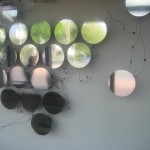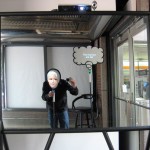By MATTHEW NASH
Collision Collective "are a group of artists from MIT and the Boston area exploring new technologies," says their website. This has led them in many different directions creatively, and (not coincidentally) often results in exhibitions whose curatorial vision is quite broad, in which artworks seem bound more by technology than concept. I mention this because, overall, "Superartificial" is one of the most cohesive shows I've seen from the Collective. This is not to say that the show is completely unified, but some thought and exploration can tease out a number of interesting and complex ideas from this diverse body of work.
On the surface, the most obvious theme is that of mirroring, sometimes in a literal sense, and more often in a metaphorical way -- mediated, of course, by technology. Collision Collective leaders jackbackrack and William Tremblay put this forward in their curatorial statement:
As we assembled the show, common themes emerged: Mirrors and their associated curses to identity, the elusive pursuit of perfection, and the ongoing attempt to reconcile the disjointed worlds of the humanities and technology. We see this exhibition as a small part of the necessary process of teaching ourselves to live, as a society, with the technology we depend upon.
Looking to the work, we can see this play out in a number of ways. Tim Murdoch's piece Who's That presents us with a literal mirroring of the world. His mirrors, however, are mounted on springs and attached to motors. The scene reflected is distorted, like looking through someone else's glasses, and while we recognize the reflection we are also aware of its artificiality. Ultimately, the world becomes a simulacrum created by its own self-distorting representation.
Similarly, Rob Gonsalves and Chris Fitch include mirrors in their representation of the world. In Masked Thoughts, Gonsalves has set up two white cutouts on the tops of poles. One cutout is in the shape of a head, with two holes for eyes, and the other is in the shape of a thought bubble from a cartoon. Looking through the eye-holes, one sees their reflection in a large mirror, with images projected on the two cutouts: faces of politicians, historical or pop culture figures appear, while bits of text fill the thought balloon. Rotating the cutout changes the image or text. Masked Thoughts is a fun and funny play on the identities we adopt when we place an intermediary technology between our selves and others.
Fitch presents a much more contemplative experience in his piece Falling. Viewed from the outside, we see a box with various chains looped through it, driven by gears on the top. Placing one's head in the opening, however, offers an immersive experience. Mirrors reflect one's face back on three sides, while the moving chains pass through the intermediary space, creating a sense of falling rain. As the chains move down, one's reflection seems to move up, rising above the space of the gallery, transcending the body.
More metaphorical mirrorings can be found in the work of jackbackrack's consensus, a computer program that mimics group behavior, and Dan Roe's Trillobita Elecctronica , a robotic "bug" that responds to light. Joseph Farrbrook's Underneath the Skin proposes that "[t]he multiplicity of meanings of the term "skin" and its psychological components are mirrored in de-familiarized skin imagery and abbreviated digitization." This takes the form of a human face, presented in wireframe, with fragments of text flashing across the surface.
In a light-hearted look at the simulacrum of mediated (or mirrored) reality, John Slepian's cornered offers both a three-dimensional experience and a digital one. Here, underneath a tree stump, lies a furry creature that grows scared the closer the viewer gets. It shakes, rustling the leaves, and on a computer screen inside the stump we see the cute, fuzzy virtual thing quiver and twitch. cornered is reminiscent of the extremely simulated worlds created by Disney, in which all experiences are anthropomorphized. The creature hiding inside the tree stump is wholly artificial, yet our response mimics that which we would have in the "real world" -- empathy, curiosity and exploration.
The remaining pieces in the show are often interesting, but their relationship to the larger theme is hard to deduce. Andy Zimmerman's Flower in Ball in Floor glows and undulates, but to what purpose? His artist statement claims that "[i]t allies itself with those fairy-tale flowers that grow stronger when you believe in them." Seeing the Future by Dan Paluska and Jeff Lieberman, is a photograph (presumably) of the artists, holding large silver spheres. They are in a living room, in front of a bookcase and a framed photograph, staring blankly outward. Both pieces seem to present ideas that may be rich in content but are not accessible through the work itself, the artists' statements, or the larger curatorial vision of the show.
Roy Pardi's Indicator 0x02 (Snake) is an interesting look at the intersection of the traditional arts with digital technology, but the blinking lights seem to fall short of that goal when compared to the overwhelming technical capacity demonstrated by other artists in the show. Pardi's work seems to be made more for a "fine arts" context than a "new media" gallery. Mark J. Stock's Perpetuity? is also somewhat out of context. This digital image "questions the directionality of time and the inevitability of cultural frictions" through digitally rendered shapes that morph and twist over each other. While visually interesting, Stock's intended references to "the change of thought within science and art in the late 19th century" invoke questions different than the curators' notions of "the disjointed worlds of the humanities and technology".
The final piece in "Superartificial" mines contemporary politics and pop culture for its themes. The Sound and the Fury, by Georgina Lewis, is a large swath of black latex mounted to the ceiling of the gallery. The black shape has jagged, squared-off edges around a symmetrical form, shaped roughly like a body. Down the center, like a spine, is a zipper sewn into the latex, which is open and reveals a standard "Exit" sign that could be found in any office building. It is disturbing to look up and see an exit that is not attainable, seen through a zippered gash in this human-like form. Still more disturbing is the fact that the shape of the latex is based on an audio waveform of George W. Bush speaking the word "war". Lewis has hung Bush's war over us, with an exit that is out of reach except through an open wound.
"Superartificial" is, like all Collision Collective exhibitions, full of diverse works that explore technology, human experience and the intersection of humanity with our devices. While not wholly cohesive as a curatorial statement, this show presents some interesting and exciting works that delight and challenge our perceptions of ourselves. "Superartificial" is, more than anything, a show about questions rather than answers, but it is where our thoughts lead us when we consider these notions that makes this work worthy.
- Tim Murdoch, Who’s That, 2008.
- John Slepian, cornered, 2008.
- Rob Gonsalves, Masked Thoughts, 2008.
Axiom Gallery
Collision Collective
"COLLISION1101:superartificial" is on view May 9 - 25, 2008 at Axiom.
All images are by the author and courtesy of Axiom.







